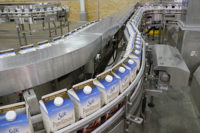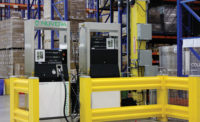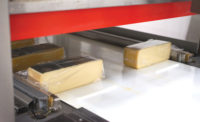The next generation of cold storage distribution and food processing plants boasts a future filled of automated equipment and energy efficient construction. But, it’s the green features that help companies produce and store cold foods in a more sustainable manner.
Here’s a breakdown of what some of today’s refrigerated and frozen food processors and distributors are doing to launch their manufacturing plants into the future.
Smithfield Foods—achieving the ultimate in sustainability
Food safety and quality are pillars to Smithfield Foods’ sustainability program. That’s why the third installment of its sustainability report showcases its commitment to producing safe, quality food.
“Our report includes multiple case studies,” says Bill Gill, assistant vice president of sustainability for the Smithfield, Va.-based company. “The ‘Inside a Smithfield Food Laboratory’ case study offers readers a scientific look into our in-house food safety research lab. Our laboratory tests, validates and evaluates the latest in food safety technologies.”
In 2016, Smithfield Foods invested $20 million to upgrade refrigeration, cleaning and sanitation systems, physical integrity maintenance of facilities and the installation of new product and environmental testing equipment.
Smithfield Foods also announced plans to upgrade its Tar Heel, N.C., distribution facility to include blast cell cold storage capabilities that will increase the facility’s capacity by 140 million pounds.
As far as green food processing, Smithfield Foods continues to make progress toward the following goals—10% water reduction, 10% waste reduction and 5% energy reduction, as well as reduce greenhouse gas emissions 25% by 2025.
“We aim to accomplish this by using a variety of measures such as high-efficiency motors, variable frequency drives, updated refrigeration control systems, recycling and water reuse. We also use biogas as a substitute for natural gas in plant boilers,” adds Gill.
In 2016, Smithfield Foods recycled 27,288 tons of cardboard. Its Middlesboro, Ky., plant sends 23% (109,000 pounds) less plastic to the landfill and saves more than $110,000 per year. Smithfield Foods’ new sustainability report also revealed the company’s first company-wide water policy, which outlines efforts to reduce impact on water resources across all operations. For instance, the Yuma, Colo., plant employs new systems to conserve water on farms. The Ilawa, Poland, facility structured new procedures to reduce the amount of water used in production and the volume of wastewater created. And, the Milan, Mo., location maintained its outstanding multi-year air, water and waste compliance record.
In April, Smithfield Foods introduced Smithfield Bioscience, which supplies byproducts from the meat production process for the development of pharmaceuticals, nutraceuticals and medical device solutions.
And, the company released Smithfield Renewables, a new platform within the organization that will unify, lead and accelerate its industry-leading carbon reduction and renewable energy efforts.
“Our commitment to sustainability exists at every level and across all our operations,” adds Gill. “It is important to have support from our executive leadership and employees across the company, from our farms to our facilities day in and day out.”
Straus Family Creamery—instituting organic farming practices
In July, Albert Straus of Straus Family Creamery, Marshall, Calif., launched what is said to be the first full-scale electric truck powered by cow waste. This environmentally-friendly alternative to diesel-fueled trucks features an electric motor powered from batteries charged from electricity generated from cows’ waste.
“It took us 8 years to develop this vehicle, with failures along the way. But, we kept trying. We worked with a local mechanic and an electric vehicle expert to adapt the engine of a 33,000-pound gross weight international harvester truck,” says Straus, organic dairy farmer, founder and CEO. “The feed truck measures, mixes and hauls feed before dropping the feed into the trough for my nearly 300 cows. I think it’s a significant benefit to have the cows actually power the truck that feeds them.”
Organic farming practices are the foundation of Straus Family Creamery’s sustainability efforts.
“Renewable energy has been a focus of my sustainable organic farming practices and creamery from the very beginning,” adds Straus. “My methane digester has been operating on the farm since 2004, and powers smaller vehicles and some farm equipment in addition to the new electric feed truck. At the creamery, we purchase 100% renewable electricity from California wind and solar sources through our partnership with Marin Clean Energy’s Deep Green Renewable Program. This change immediately decreased our operational greenhouse gas footprint by 20%. We also finished an extensive 5-year initiative to reduce water consumption at our creamery. We reduced normalized water use by 30% from 2011-2016. We use a system that allows us to reuse all the water from the creamery at the Straus dairy farm; it is used to flush the barns, help with electricity generation for the methane digester and irrigate pastures. We’ve installed energy efficient equipment like LED lighting and reduced our landfill impact by boosting our recycling efforts. These practices have reduced costs, and in some cases, provided new small revenue streams.”
Bongards’ Creameries—managing waste from beginning to end
Bongards’ Creameries, Bongards, Minn., is expanding its Humboldt, Tenn., plant to feature automated case packing and palletizing systems, including robotic palletizing, a variable retention cooling system for hot-filled products and a new order picking system with automated guided vehicles capable of placing, picking and staging pallets as guided by the warehouse and order systems.
The company’s Perham, Minn., natural cheese facility uses heat from the county’s adjacent waste incinerator to produce steam, which is then used by the plant as part of the cheese production process. Wastewater is also fully treated, then reused to irrigate crops.
And, the company’s headquarters facility leased space for a 40-acre solar garden to satisfy all of the plant’s electricity needs.
“As a company, we’re very committed to incorporating sustainable attributes in our facilities,” says Brent Jewett, vice president of operations. “Our team is currently researching the potential sale of manufacturing byproducts to methane digesters and energy companies, which would provide low-cost inputs and minimize waste from our production processes.”
Solve for Food—employing MATS technology for e-commerce influx
Just a few short months ago, Solve for Food (SFF), Bentonville, Ark., received an investment to break ground on a new technology center that will feature MATS technology, which uses a combination of hot water bath and microwave energy to quickly and safely sterilize packaged food.
“By providing MATS on a tolling basis, we remove the barrier to entry to next-generation food processing,” says Greg Spragg, president and CEO. “SFF gives all food companies, particularly food startups and small companies, access to the new MATS preservation technology.”
The SFF Food Innovation Center will be a destination for brands and innovators to utilize MATS technology to create better packaged food products and receive go-to-market services.
“High-quality packaged foods that can be shipped and stored at ambient temperature are the lynchpin for food e-commerce providers,” says Spragg. “The ability to package a wide variety of protein-rich, shelf-stable foods also makes MATS a sustainable solution for producing humanitarian rations. Located in close proximity to agricultural hubs will allow SFF food production centers to quickly capture surplus crops, minimizing losses due to waste and spoilage.”
NatureFresh Farms—preserving heat in the greenhouse
NatureFresh Farms, Canada, uses high-pressure sodium lighting to supplement growing practices in off-peak farming conditions, such as winter. How it works is, NatureFresh Farms recaptures CO2 for fertilizer on the plants.
“This is because we burn natural gas for heat at a 98% efficiency. We store the heat for when needed and blow the CO2 into the greenhouse to use as fertilizer for the plants,” says John Ketler, general manager. “When we irrigate, whatever drains out of the plant is recaptured, sterilized and then reused again. Therefore, 0% of fertilized water gets dumped into the ditches.”
When it’s cold outside, NatureFresh Farms uses energy curtains in the greenhouse to act as an insulation barrier. Plus, all of its waste material is recycled and/or composted, and the company burns wood for one quarter of its heat supply.
Country Hen—creating moisture-resistant egg carton made from recycled materials
The Country Hen, Hubbardston, Mass., completed a state-of-the-art facility that employs radiant heating systems to ensure the hens in the barn remain warm. The plant also features LED dimmable lighting, which creates a natural sunrise and sunset effect, easing the hens from the transition of light to dark or dark to light. And, the newly installed 350,000 kw solar energy system provides enough power to continuously operate the main production farm, feed mill, processing lines and the new facility.
“The Country Hen built this new facility to provide the most natural, healthiest life for our hens. This commitment to our hens is part of our continued leadership in organic agriculture,” says Brandy Gamoning, marketing manager. “The Country Hen is also in the beginning stages of moving toward a durable, sturdy, humidity and moisture-resistant egg carton made from recycled materials. With this new packaging, customers will be able to view the eggs without having to open the carton, and the eggs will be protected from breakage as a result of the innovative trifold design.”








